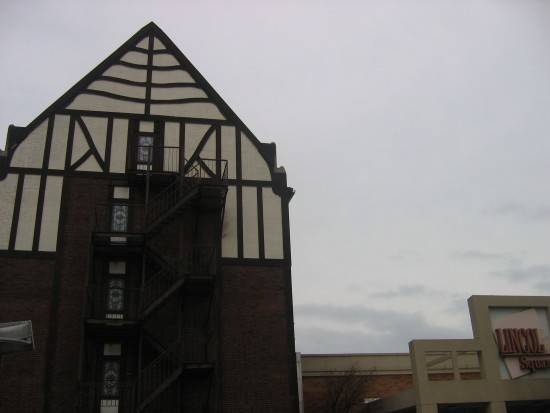
The hotel, a faux-Tudor monstrosity, is a defiant architectural malady, literally crenelated so that archers might defend against the encroaching public library or dump cauldrons of boiling oil onto those who reasonably might consider it acceptable to park in its downtown parking lot, which is always empty save for the weeds sprouting through the cracked asphalt.
The acrid stench of a recently-used locker room permeates the hallway outside the pool area. The sign on the door — CLOSED FOR REPAIRS — is the only evidence of repairs to be found in the building. The pool is almost drained, but a few inches of brown water stagnate in the former deep end.
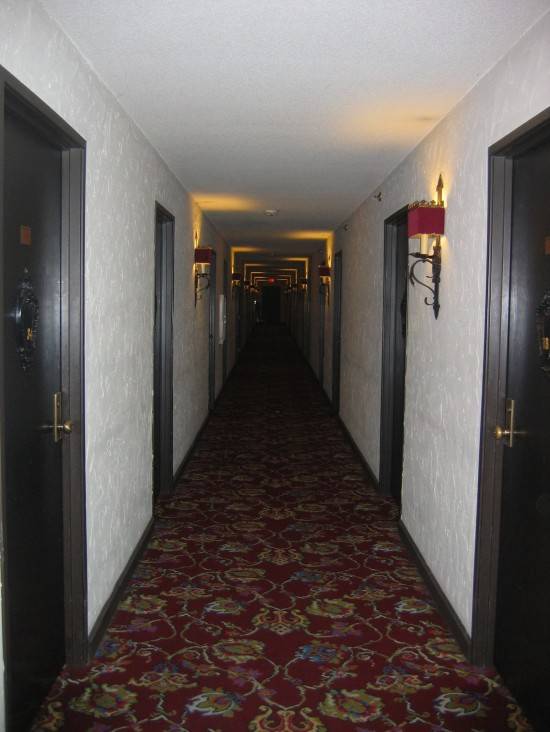 Although it is sunny outside, the hallway ceiling discharges a spurt of water, missing the bucket placed nearby.
Although it is sunny outside, the hallway ceiling discharges a spurt of water, missing the bucket placed nearby.
There is a cramped outdoor courtyard in which a couple of lawn chairs, surrounded by piles of building debris and scraps of wrought iron, attempt to enjoy the small triangle of sunlight.
The musty elevator is walled with a thick and oppressively festive burlap-textured fabric redolent of mildew.
Although the indoor smoking ban has been in effect for some years, an ashtray on a hearth near the elevator cradles an ancient cigarette butt and other fulsome debris.
An alarming light fixture fashioned from antlers has proven an ideal environment for cobwebs.
Eerie stucco corridors snake through the building, half-lit by battered gothic fixtures, muffled by an inadvisable baroque patterned carpet laid over creaking, uneven flooring.
Nothing says “class” like a hand-made sign taped to the fourth-floor wall: LOST FERRET. DO NOT ATTEMPT TO CAPTURE. NOTIFY FRONT DESK.
Terrified deer caught in a painting of muddy forest. Still life with rancid pomegranate and burning cigarette.
Ranks of untenanted rooms molder behind scuffed wooden doors stamped with medieval type. Some are special venues bearing mysterious titles in blackletter German. (“I’d like to place a reservation for DACHAU.”)
There are no signs of guests.
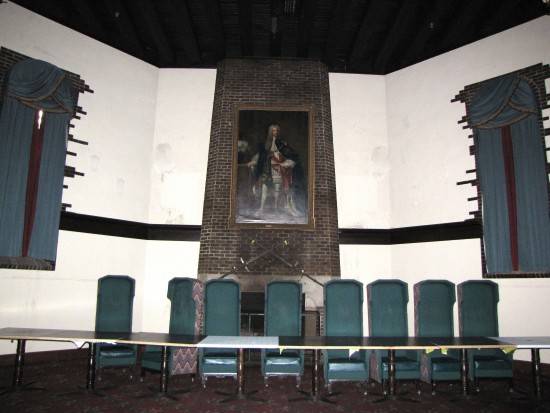 More disturbing than the absence of any living human being in the hotel is a DO NOT DISTURB sign on a single room door.
More disturbing than the absence of any living human being in the hotel is a DO NOT DISTURB sign on a single room door.
Is the silence more frightening than the dripping of the broken ice machine, or the occasional gastric rumbling from the bowels of the structure?
An unlit exit sign hangs beside a stub of a corridor with no doors, leading nowhere.
There are so many places to hide a body.
It smells like a great aunt’s apartment, a place one would arrange to visit as infrequently as possible.
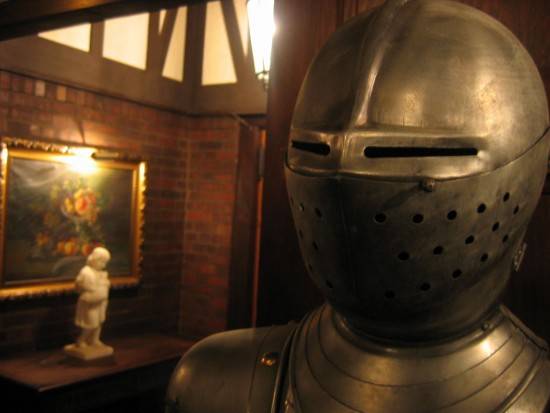 The stairway feels not much less unsafe than the elevator. The floor is chalked with a scatter of fallen plaster. A decapitated railing post is a hollow column now treated as an ad-hoc trash receptacle by disrespectful guests, staff, or vagrants. An abandoned kernel of candy corn lies on the third floor landing, awaiting the lost ferret. Some prankster has left a Lite beer can lying on a handrail. For the sake of decorum, cleaning staff has used pencil to scribble over graffiti in the stairwell, though they have overlooked the inscription reading “I WILL KILL YOU.” Or else they wrote it. Spent Twix wrappers tell a tale of indulgence leading down to the first-floor door, behind which a narrow flight of steps down to the lobby is tremendously and unpleasantly overheated from an unnecessary chandelier.
The stairway feels not much less unsafe than the elevator. The floor is chalked with a scatter of fallen plaster. A decapitated railing post is a hollow column now treated as an ad-hoc trash receptacle by disrespectful guests, staff, or vagrants. An abandoned kernel of candy corn lies on the third floor landing, awaiting the lost ferret. Some prankster has left a Lite beer can lying on a handrail. For the sake of decorum, cleaning staff has used pencil to scribble over graffiti in the stairwell, though they have overlooked the inscription reading “I WILL KILL YOU.” Or else they wrote it. Spent Twix wrappers tell a tale of indulgence leading down to the first-floor door, behind which a narrow flight of steps down to the lobby is tremendously and unpleasantly overheated from an unnecessary chandelier.
A tall, dim, brooding banquet room suggests a corrupt monarchy who, before their fall, feasted on beheaded boars and goblets of goat’s blood. This grim hall is furnished with cheap particleboard tables. Grotesquely heavy chandeliers overpopulate the ceiling. Thick green curtains tied with braided gold rope hang from tall, arched brick windows that look out onto the post office. Rusted, tetanus-infected swords hang, crossed, on the hearth. Huge paintings of dead Germans frown morbidly above the long table where wedding parties or royalty must sit in towering, rigid wooden thrones.
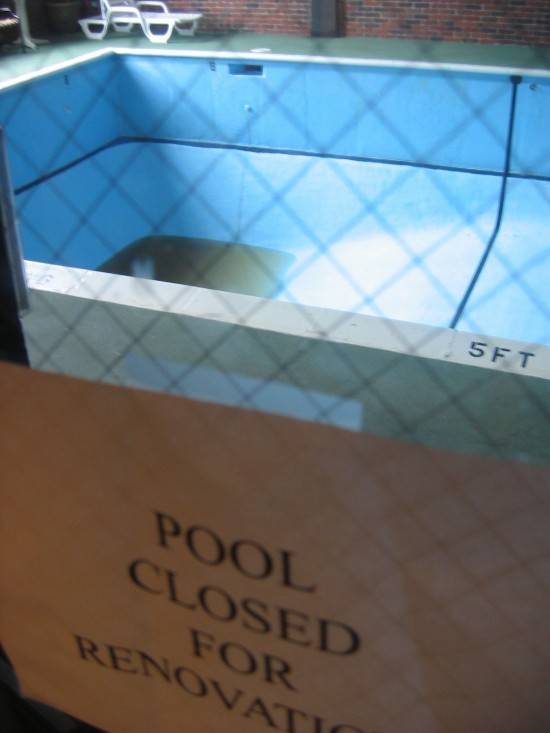 There is nobody at the front desk, nobody in the lobby but two suits of armor flanking the door leading out into the mall food court. Only the hourly announcement of a grandfather clock lances the pustulant silence. As a welcoming touch, a piano has a sheet of paper reading DO NOT USE. More heavily framed portraits of Teutonic elders stare accusingly into the room. Sculptures of unknown deities add a funereal accent. A stitched deer head mounted over a doorway stares off, blisslessly unaware that the tragedy of its execution has been compounded by the tragedy of this interior decoration. The musty ambiance oozes nostalgia for a simpler time, before penicillin: an era of leeches and bloodletting, patriarchy, guillotines, chamber pots, slavery, and bubonic plague.
There is nobody at the front desk, nobody in the lobby but two suits of armor flanking the door leading out into the mall food court. Only the hourly announcement of a grandfather clock lances the pustulant silence. As a welcoming touch, a piano has a sheet of paper reading DO NOT USE. More heavily framed portraits of Teutonic elders stare accusingly into the room. Sculptures of unknown deities add a funereal accent. A stitched deer head mounted over a doorway stares off, blisslessly unaware that the tragedy of its execution has been compounded by the tragedy of this interior decoration. The musty ambiance oozes nostalgia for a simpler time, before penicillin: an era of leeches and bloodletting, patriarchy, guillotines, chamber pots, slavery, and bubonic plague.
I would like Lincoln Square — according to some reports, one of America’s oldest indoor malls (which, in my childhood, was a fun and thriving retail shopping center, and once even held a good record store) — to survive.
I am especially encouraged by the prospect of the mall turning from a retail center to a community center, with the long-standing Farmer’s Market joined by the more recent additions of the Independent Media Center, the Common Ground Food Co-op, Eighty-Eight Main, Cardinal Fitness, the mysterious art center that for a time offered weekday drawing classes for unemployed adults and truants, the conspicuously over-designed Senior Odyssey, and the nascent Amara Yoga & Arts Center. I envision a cluster of non-profits, locally-owned businesses, performance spaces, kiosks: places of physical, intellectual, and political development and expression; places more of congregation than commerce.
But this decrepit Tudor nightmare hotel, architecturally welded directly onto the mall structure, may be beyond restoration. Its four empty floors should be opened as a barracks for the local homeless population. Can the mall find a new utility in this new century with this “historic” building, anachronistic down to its 50-year-old dirt, hanging on it like an algae-encrusted barnacle on a steamship?
——
If you enjoyed this article, Smile Politely also recommends:
+ Twelve-bar news: Roy Zimmerman at the IMC
+ Generation Exxay
+ Ageless Smoking Popes reel ‘em in at Courtyard
+ Honoring Chimesmaster Wood and the Altgeld Bell Tower
+ Steel Wheels, Green Fields: A Day on an Illinois Freight Train








